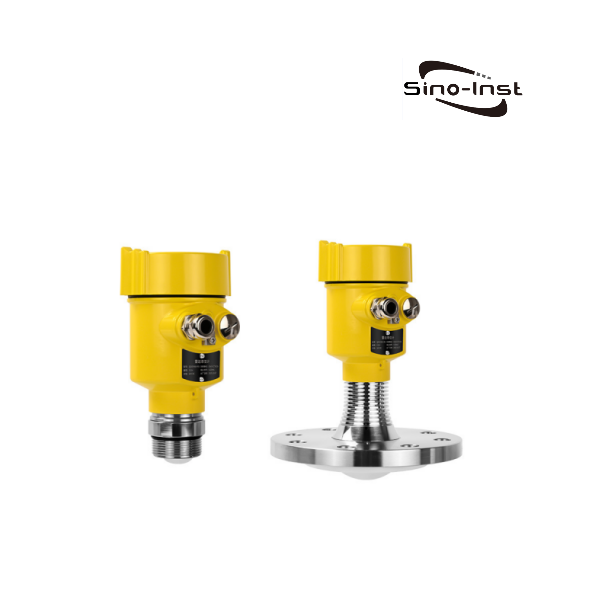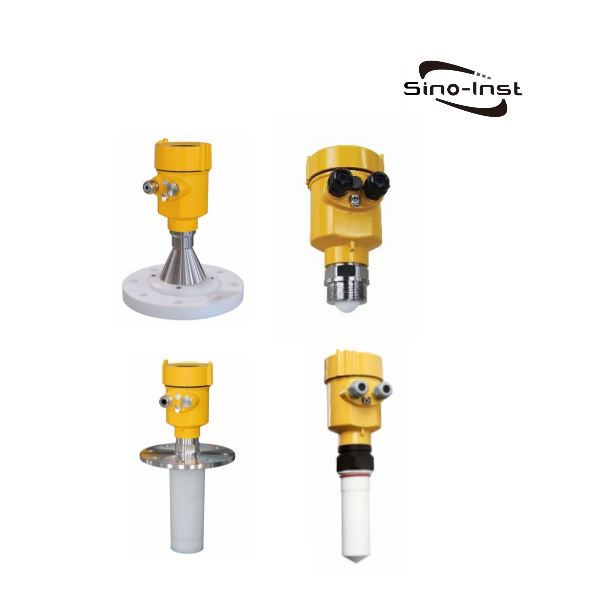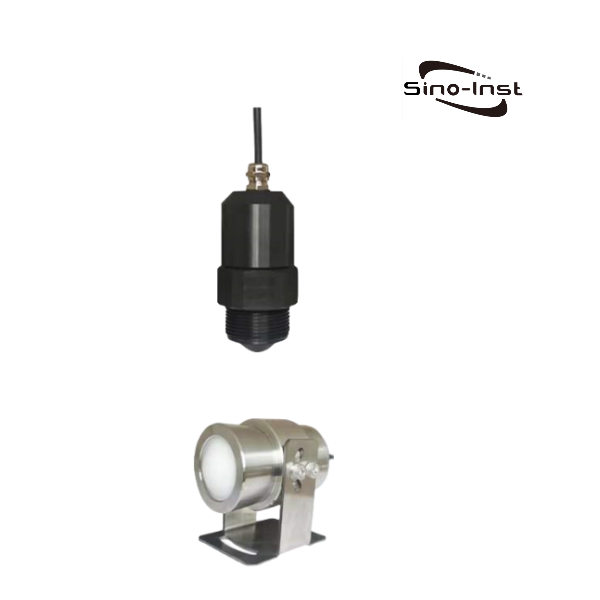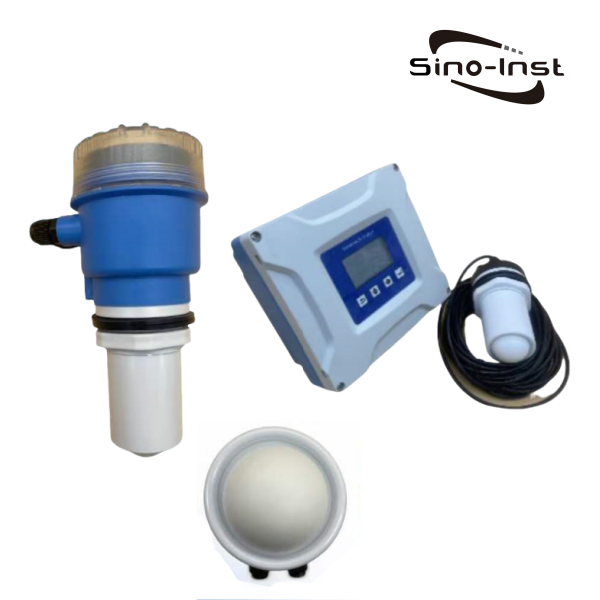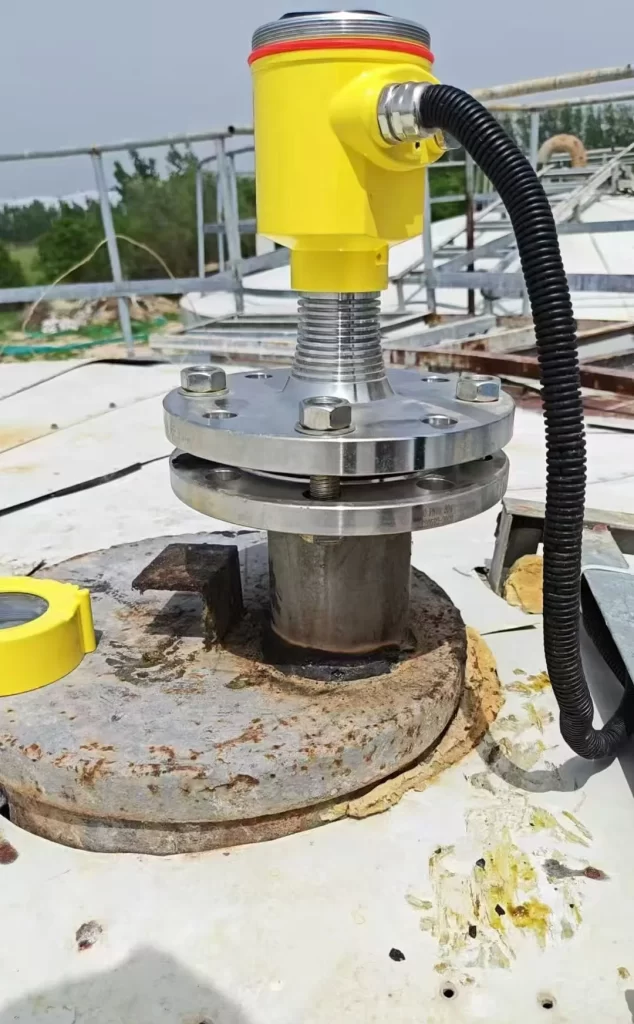
Tank level monitoring is critical in industrial production. Radar level gauges provide real-time water level measurements with exceptional accuracy. Consequently, they have become the preferred choice for industrial-level monitoring.
Radar level gauges offer an ideal solution for chemical storage tanks, oil fields, and reservoirs. In large tank installations, they achieve measurement accuracy of ±2mm—significantly surpassing traditional float-type or differential pressure level transmitters.
What Is a Radar Level Gauge?
Radar level gauges are industrial instruments used to measure the height of liquids or solid materials within containers. They feature non-contact measurement and strong adaptability.
Equipped with high-precision radar sensors, radar level gauges measure the distance to the liquid surface from their installation point. With a measurement range up to 150 meters, they deliver accurate readings in complex environments and effortlessly handle even the most severe water level fluctuations.
Radar Level Measurement
Radar level measurement operates on the principle of electromagnetic wave reflection, calculating liquid height by emitting high-frequency radar waves and receiving their reflected signals.
The radar emits electromagnetic waves from the tank top. These waves reflect off the medium and are received by the radar. The frequency difference between the received and transmitted signals is proportional to the distance R from the medium’s surface:
R = C (speed of light) × Frequency Difference / 2
Substituting this into the formula for liquid level height (H) = Total Distance (L) – (Speed of Light × Time Difference T) / 2 allows the liquid level to be calculated.
What Are the Differences Between Ultrasonic Level Measurement and Radar Level Measurement?
| Feature | Ultrasonic level measurement | Radar level measurement |
| Working Principle | The liquid level is calculated by emitting high-frequency sound waves and receiving the reflected signals, using the sound wave propagation time. | It utilizes electromagnetic wave transmission and reception, measuring liquid level via the time-difference method. |
| Applicable Scenarios | Suitable for environments with normal pressure and temperatures below 80℃.Not suitable for vacuum, steam, or dusty environments. | Suitable for high temperature, high pressure, vacuum, or complex operating conditions. Particularly suitable for media with high dielectric constants. |
| Measurement Accuracy | Accuracy is typically centimeter-level, and the measuring range generally does not exceed 30 meters. There is a significant measurement blind zone (0.3-0.5 meters). | Accuracy down to the millimeter level. Measuring range up to 150 meters. Small blind zone (approximately 0.1 meters). |
| Installation and Cost | A bracket is required for installation. Maintenance is relatively complicated. The price is relatively low. | Flexible installation. Higher cost, but suitable for more complex operating conditions. |
Featured Radar Level Gauges
Based on antenna design and frequency differences, radar level gauges can be divided into high-frequency radar level gauges and low-frequency radar level gauges. Sino-inst offers the following types of high-frequency radar level gauges.
Radar Level Transmitter-80GHz Series-High Accuracy
The 80GHz series radar level transmitter refers to a frequency-modulated continuous wave radar product operating at 76-81GHz. It is also known as a frequency-modulated continuous wave radar level gauge. Its non-contact measurement range can reach up to 150 meters, with a blind zone of only 8-10 centimeters.
The main advantages of the 80GHz series radar level transmitter include a smaller emission angle, stronger echo signal, and stronger penetration. It supports the measurement of liquid levels in various materials such as water, acid and alkali liquids, and coal powder.
The accuracy of the 80GHz series radar level transmitter is ±1mm. If your application requires high-precision level measurement, the 80GHz series radar level transmitter should be your first choice.
Non-Contact 26 GHz Radar Level Meters | High Frequency
The 26 GHz high-frequency radar level gauge utilizes a transmission frequency of up to 26 GHz. This level gauge has a measurement range of up to 80 meters.
The 26 GHz high-frequency radar level gauge has a small measurement blind zone. It is particularly suitable for measuring small storage tanks. It also features high-frequency characteristics. So, it is the best choice for measuring solids and low-dielectric-constant media. Even under fluctuating conditions, it maintains a high signal-to-noise ratio for optimal performance.
Sino-inst’s 26 GHz radar level gauge can be customized. It can withstand temperatures up to 230°C and pressures up to 4.0 MPa. This level gauge can be used in complex environments such as corrosive liquids, steam, and volatile liquids.
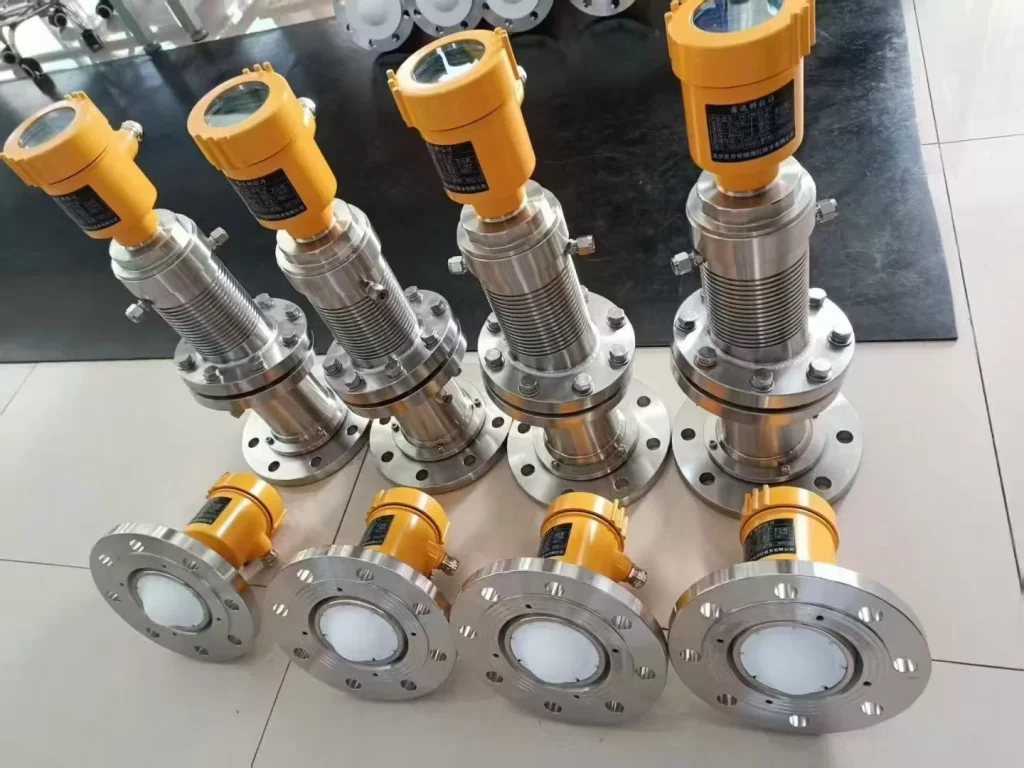
Radar Water Level Sensor | 4-20mA | RS485| 15m- 35m -85m -150m
A radar level sensor is a commonly used water level monitoring device.
The maximum measurement accuracy of a radar level sensor is ±2mm, and the minimum measurement blind zone is 0.1m. The smaller antenna size of the radar level sensor allows it to perform measurements under more operating conditions.
The Sino-inst radar level sensor can be customized with 4-20mA or RS485 signal output. Measurement ranges are selectable at 15m, 35m, 85m, or 150m. This sensor is widely used in monitoring rivers, lakes, and water conservancy facilities.
Radar Level Sensors-80G-Low Cost
The TSL300 series radar level sensor uses an 80GHz high-frequency sensor, providing strong anti-interference capabilities. It can operate normally even in environments with foam, agitation, or floating debris.
The circuit design utilizes a high-quality power module. All components are imported, offering high stability and reliability. It can completely replace similar imported instruments.
The TSL300 series radar level sensor’s housing is made of plastic. The probe and circuit board are independently developed and manufactured by our company. Furthermore, this product is cost-effective, providing you with the most cost-effective level measurement solution!
Applications
Radar level measurement for storage tanks
Tank level is a crucial parameter in oil gathering and transportation processes. Radar level gauges have become the most widely used level measurement instruments in recent years.
Radar level gauges calculate level by measuring the time difference between pulse emission and reflection. High-frequency models offer stronger penetration and are suitable for complex operating conditions.
They employ a non-contact measurement method and offer advantages. Such as easy installation, low failure rate, resistance to high temperatures and high pressures . They are currently widely used in refinery storage and transportation tank areas.
Radar level gauges for level measurement
Radar level gauges use high-precision radar sensors to measure the distance from their installation location to the water surface. This non-contact measurement provides accurate real-time water level readings without the need for expensive underwater operations.
Radar level gauges measure liquid level based on the principle of microwave ranging. They calculate the liquid level height by measuring the time difference of the reflected signal after emitting high-frequency electromagnetic waves.
Radar level gauges have no moving parts and are unaffected by temperature and pressure. The probe can be encapsulated in refractory materials such as PTFE and 316L stainless steel. They are also suitable for flammable and explosive environments.
Radar level gauges for continuous measurement
Radar level gauges are indeed suitable for continuous measurement. They support a measuring range of 0–150 meters with an accuracy of ±1 mm. They also support multiple signal outputs, including 4–20 mA, HART, and Modbus interfaces.
Radar level gauges can be used for the following continuous measurements:
- Industrial buffer tanks. The radar level gauge can withstand temperatures from -40℃ to 220℃ and pressures from -1 to 40 bar.
- Asphalt ship cargo tanks. Suitable for continuous liquid measurement, especially in complex media environments.
- Filter tanks. The 26G radar level gauge has a small beam angle (8°), strong foam/vapor penetration capability, and an accuracy of ±3 mm.

Radar level gauges for silo level measurement
Radar level gauges continuously measure the actual liquid level of bulk materials within silos. They are typically installed at the midpoint of the silo’s top radius to ensure full coverage of the material surface.
Radar level gauge parameter settings: Empty tank height (zero point) and full tank height (full scale) must be set. The measurement range is recommended to be 2-3 meters higher than the actual measuring range to ensure radar wave coverage of the container height.
Radar level gauges have no mechanical wear, low maintenance costs, and a mean time between failures (MTBF) exceeding 50,000 hours. However, periodic calibration using a cylindrical or reflector-type calibration device is still necessary to ensure long-term stability.
Benefits
- High accuracy. Radar level gauges typically have an accuracy between ±0.1% and ±1%. Some explosion-proof radar level gauges can achieve a level accuracy of ±1 mm.
- Non-contact measurement. No direct contact with materials, avoiding corrosion or contamination issues.
- Adaptable to complex environments. Can measure high-temperature, high-pressure, or corrosive media. Unaffected by noise, steam, dust, vacuum, or other operating conditions.
- Easy installation. Usually only requires fixing with a hole in the top of the container, resulting in low maintenance costs.
- Stable output signal. Supports 4-20mA current signals or digital communication protocols, facilitating system integration.
- Smaller antenna size, meeting measurement needs in more operating conditions.
- Multiple lens antennas are available, offering a smaller emission angle, more concentrated energy, and stronger echo signals.
Selection Considerations
When selecting a radar level gauge, consider the following factors:
- Medium characteristics. Liquid viscosity and solid particle size may affect signal reflection intensity.
2. Container conditions. Installation locati0n, agitation devices, or internal structures may interfere with measurements.
3. Environmental parameters.Temperature and pressure ranges must comply with instrument specifications.
4. Range requirements. Select an appropriate model based on the actual liquid level variation range.
FAQ
More Level Measurement Cases and Solutions
Case: Non-Contact Material Level Measurement – Radar Level meter
Case Study – Liquid Nitrogen Flow Measurement
Case Sharing: Explosion-Proof Ultrasonic Level Meter
Difference Between Radar and Ultrasonic Level Transmitter
Featured 5 Guided Wave Radar Level Transmitter Types
Guided Wave Radar Level Transmitter Installation Guide and Troubleshooting
Difference Between Radar and Guided Wave Radar Level Transmitter
Case Study – Implementing Four-Point Liquid Level Control Using a Float Level Switch
Radar level gauges provide real-time, non-contact level monitoring. They are unaffected by steam, dust, and high temperatures. This makes radar ideal for level monitoring in harsh environments and outdoors.
Sino-inst specializes in manufacturing monitoring instruments for level, flow, and pressure measurements. Our radar level gauges can be used in over 150 different fields. Such as crude oil, refined oil, and chemical raw materials.
If you require tank level measurement services or wish to purchase radar level gauges, please feel free to contact us.
-1.jpg)
